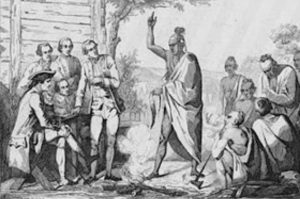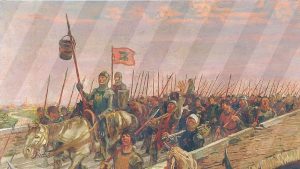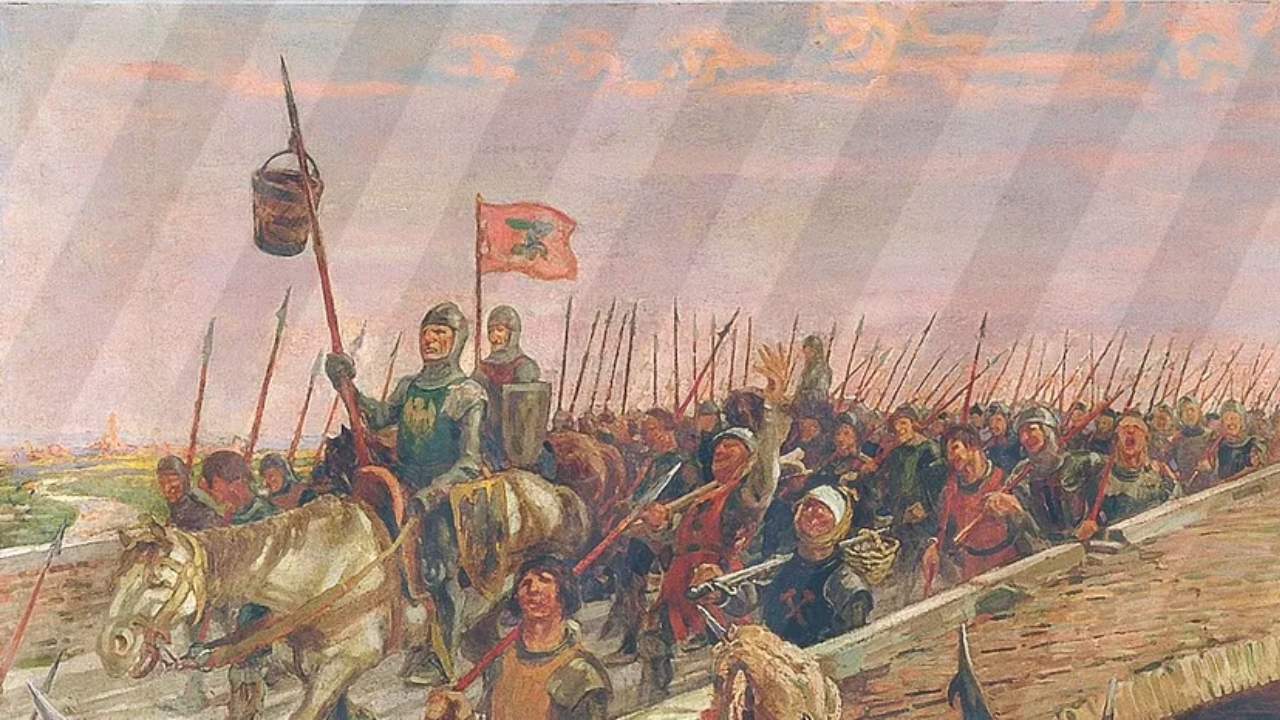War, throughout history, has often been driven by profound causes such as ideology, territory, or resources. Yet, sometimes conflicts have arisen from the most unexpected and bizarre reasons. Here are ten of the strangest wars that have ever been waged:
1. The War of the Stray Dog (1925)

The War of the Stray Dog in 1925 was a peculiar conflict between Greece and Bulgaria, sparked by a seemingly insignificant incident along their shared border. It began when a Greek soldier’s dog strayed across the border into Bulgarian territory near the town of Petrich. The soldier followed his dog into Bulgaria, where both he and the dog were subsequently shot dead by Bulgarian border guards.
This incident provoked a swift and dramatic response from Greece. Outraged by the killing of their soldier and his dog, Greece mobilized its military and launched an incursion into Bulgarian territory. What started as a border skirmish quickly escalated into a full-scale conflict, with artillery fire exchanged and casualties reported on both sides.
The international community, particularly the League of Nations, intervened to mediate the dispute and prevent further escalation. After just ten days of fighting, Greece and Bulgaria agreed to a ceasefire on October 29, 1925. The conflict ended with both sides returning to their pre-war positions, and peace was restored.
The War of the Stray Dog, while brief and relatively minor in terms of casualties, highlighted the underlying tensions and historical grievances between Greece and Bulgaria in the aftermath of the Balkan Wars and World War I. It also underscored how a small, accidental incident could ignite armed conflict between neighboring states during a fragile period of European geopolitics.
In conclusion, the War of the Stray Dog serves as a reminder of the unpredictability of international relations and the potential for conflicts to arise from seemingly trivial events, leaving a mark on the history of the Balkans and international diplomacy in the interwar period.
2. The Pig War (1859)

The Pig War of 1859 was a unique and bloodless conflict between the United States and the United Kingdom (then ruling Canada) over a boundary dispute in the San Juan Islands, located between Vancouver Island and mainland Washington State.
The dispute arose from the vagueness of the Oregon Treaty of 1846, which aimed to settle competing claims over the region but left the exact boundary undefined. Both American settlers and British subjects occupied the San Juan Islands, leading to occasional tensions over land use and sovereignty.
In June 1859, a trigger event occurred when an American farmer named Lyman Cutlar found a large black pig rooting in his garden on San Juan Island. Upset by the pig’s intrusion and the damage it caused to his crops, Cutlar shot and killed the pig, which happened to belong to Charles Griffin, a British subject and employee of the Hudson’s Bay Company.
Griffin demanded compensation for the loss of his pig, but Cutlar refused, arguing that the pig had been trespassing on his property. The incident quickly escalated as both sides reinforced their military presence on the island. The American military dispatched troops under the command of Captain George Pickett (later famous for Pickett’s Charge in the Civil War), while the British sent Royal Marines and warships to the area.
Despite the military buildup, neither side engaged in combat. Instead, both governments opted for diplomacy to resolve the situation peacefully. Over the next several months, diplomats from the U.S. and Britain negotiated a joint military occupation of the San Juan Islands until a final settlement could be reached.
In 1872, Kaiser Wilhelm I of Germany, acting as arbitrator under the Treaty of Washington, sided mostly with the U.S. in defining the boundary through the Haro Strait, marking the end of the dispute. The Pig War thus became an example of how international conflicts can be resolved without bloodshed through diplomacy and arbitration, although it was triggered by a rather unusual and trivial incident involving a pig.
3. The War of Jenkins’ Ear (1739-1748)

The War of Jenkins’ Ear was a conflict between Britain and Spain that lasted from 1739 to 1748, primarily fought in the Caribbean and on the coasts of Georgia and Florida. The war was named after an incident involving Robert Jenkins, a British captain whose ear was allegedly severed by Spanish coast guards in 1731 as punishment for smuggling.
In 1738, Jenkins appeared before the British Parliament holding his preserved ear, recounting his mutilation at the hands of the Spanish. This incident, coupled with growing tensions over trade disputes and Spanish interference with British shipping in the Caribbean, became a rallying cry for war among British officials and the public.
The formal declaration of war came in October 1739, marking the beginning of hostilities. British forces launched attacks on Spanish possessions in the Caribbean and Central America, aiming to disrupt Spanish trade and weaken their colonial holdings. Spanish forces retaliated by besieging British settlements in Georgia and launching naval assaults against British ships and territories.
The war saw significant naval engagements, including the Battle of Cartagena de Indias in 1741, where a large British fleet under Admiral Edward Vernon failed to capture the Spanish port in present-day Colombia. Both sides also engaged in privateering, with privateers commissioned by both Britain and Spain raiding enemy merchant ships and disrupting trade routes.
Despite its initial motivations rooted in the Jenkins incident, the War of Jenkins’ Ear became subsumed into the broader War of the Austrian Succession (1740-1748), involving multiple European powers. The conflict in the Caribbean and North America continued as part of this wider war until the signing of the Treaty of Aix-la-Chapelle in 1748, which restored most captured territories to their pre-war status quo ante bellum.
While the war did not decisively resolve many of the underlying colonial disputes between Britain and Spain, it highlighted the fragility of peace in the Atlantic world and the strategic importance of colonial possessions in the Americas during the 18th century.
4. The Football War (1969)

The Football War, also known as the Soccer War, erupted in 1969 between El Salvador and Honduras, two Central American nations with longstanding political and socioeconomic tensions. The conflict was triggered by a series of contentious matches during the qualifying rounds for the 1970 FIFA World Cup.
Tensions between the two countries had been escalating for years due to issues such as immigration, land reform, and economic disparities. These factors were exacerbated by the matches between their national football teams, which stoked nationalistic fervor and led to violent incidents both on and off the field.
The situation reached a tipping point on June 27, 1969, after the second-leg match in Mexico City, which Honduras won, eliminating El Salvador from World Cup contention. In the following days, anti-Honduran sentiment in El Salvador boiled over, resulting in violent attacks against Honduran immigrants and diplomatic personnel.
On July 14, 1969, the Salvadoran military launched a full-scale invasion of Honduras, citing the protection of Salvadoran citizens and the need to address long-standing grievances. The conflict quickly escalated into a brief but intense war, with both countries engaging in air strikes, ground battles, and naval skirmishes.
The Organization of American States (OAS) brokered a ceasefire on July 18, just four days after the conflict began. The ceasefire was followed by peace negotiations mediated by the OAS and other regional powers. A formal peace treaty, known as the “Protocol of Esquipulas,” was signed on October 30, 1980, which officially ended hostilities and established measures for resolving border disputes and improving bilateral relations.
The Football War, despite its short duration and relatively low casualty count compared to other conflicts, had significant implications for Central American stability. It underscored the fragility of regional peace and the potential for sporting events to inflame nationalist sentiments and trigger armed conflict. The war also highlighted the complex interplay of socioeconomic factors and historical grievances that continue to shape relations between countries in the region today.
5. The War of the Bucket (1325)

The War of the Bucket, occurring in 1325, was a bizarre conflict between the Italian city-states of Bologna and Modena over a stolen wooden bucket. The exact details of the incident are obscure, but it is believed that Modenese soldiers raided Bologna and absconded with a prized wooden bucket from a city well. This seemingly trivial act provoked a significant response from Bologna, leading to a full-scale military retaliation.
The conflict escalated quickly as Bologna mobilized its forces and launched an attack on Modena. Despite the humorous and seemingly inconsequential nature of the cause, the war resulted in several serious battles and casualties on both sides. The neighboring city-states of Ferrara and Florence were drawn into the conflict, supporting either Bologna or Modena based on their political alliances and interests.
The War of the Bucket continued for several months, with sporadic fighting and skirmishes as both sides struggled for control. Eventually, a peace treaty was brokered in 1325, which returned the bucket to Bologna but failed to resolve deeper animosities between the rival cities.
While the War of the Bucket is often regarded as one of the more absurd conflicts in history, it underscores the intense rivalries and territorial disputes that characterized medieval Italian city-states. These states often engaged in wars over trivial provocations or slight offenses, fueled by pride, honor, and a desire for dominance in the region.
Despite its humorous beginnings, the War of the Bucket serves as a reminder of the intricate and sometimes volatile nature of political and military dynamics in medieval Europe, where conflicts could arise from the most unexpected and mundane provocations.
6. The Pastry War (1838-1839)
The Pastry War, also known as the First French Intervention in Mexico, was a brief but peculiar conflict that occurred between France and Mexico from 1838 to 1839. The conflict was triggered by a series of incidents involving French citizens and businesses in Mexico, which culminated in a demand for financial reparations by the French government.
In the early 1830s, Mexico underwent political instability and transition following its independence from Spain. During this period, French citizens living in Mexico, particularly pastry chefs and bakery owners, faced harassment, property damage, and looting by local Mexican forces. These incidents were exacerbated by political tensions between the Mexican government under President Anastasio Bustamante and foreign interests, including French economic investments.
One of the pivotal events occurred in November 1838 when a French pastry chef named Remontel claimed that Mexican officers had damaged his shop in Tacubaya. In response, the French government, under King Louis-Philippe, demanded a substantial indemnity payment of 600,000 pesos from Mexico as compensation for damages suffered by French citizens. When Mexico failed to meet the demands within the stipulated time frame, France launched a naval blockade and military campaign against Mexican ports and coastal cities.
The conflict saw French forces led by Admiral Charles Baudin bombarding and occupying Veracruz, a key Mexican port city, in December 1838. Despite initial successes, the war was short-lived due to international pressure and diplomatic negotiations. In March 1839, a peace agreement was brokered between France and Mexico, known as the Treaty of Pastry, which stipulated compensation for French losses and restored diplomatic relations between the two nations.
While the Pastry War itself had minimal lasting impact on Mexican territory or governance, it highlighted European intervention in Latin American affairs during the 19th century and underscored the vulnerability of newly independent nations to foreign economic and military pressure. The conflict remains notable for its unusual origins and the disproportionate response it elicited from France over the mistreatment of its citizens abroad.
7. The War of the Golden Stool (1900)
The War of the Golden Stool, also known as the Yaa Asantewaa War, occurred in 1900 in the Gold Coast (modern-day Ghana) between the British Empire and the Ashanti Empire. The conflict was sparked by British attempts to assert control over the Ashanti region and the symbolic significance of the Golden Stool, a sacred symbol of Ashanti unity and kingship.
Tensions between the Ashanti people and the British colonial authorities had been escalating for years due to British encroachments on Ashanti territory and attempts to impose indirect rule through local leaders. The final straw came in 1896 when the British Governor of the Gold Coast, Sir Frederick Hodgson, demanded to sit on the Golden Stool, believing it would symbolize Ashanti submission to British rule.
The Ashanti people, led by Queen Mother Yaa Asantewaa, fiercely resisted British attempts to seize the Golden Stool. Yaa Asantewaa rallied the Ashanti troops, declaring, “If you, the men of Ashanti, will not go forward, then we will. We, the women, will.” This marked a significant moment of defiance against British colonial authority and a rallying cry for independence.
In March 1900, tensions erupted into open warfare when the Ashanti launched attacks on British positions and forts in the region. The British, under General Sir Francis Scott, responded with military force, deploying troops and artillery against the Ashanti warriors.
The conflict was brutal and protracted, with both sides suffering casualties. However, the superior firepower and reinforcements of the British eventually overwhelmed the Ashanti forces. Queen Mother Yaa Asantewaa was captured and exiled to the Seychelles, where she died in 1921.
The War of the Golden Stool marked a significant chapter in the resistance against British colonialism in Africa. While the Ashanti were ultimately defeated militarily, the war demonstrated their fierce determination to defend their sovereignty and cultural symbols against foreign intrusion. The legacy of Yaa Asantewaa and the Golden Stool remains a powerful symbol of Ghanaian nationalism and resistance to colonial oppression.
8. The Emu War (1932)
The Emu War, occurring in Australia in 1932, was a peculiar conflict between Australian soldiers and emus—large flightless birds native to the country. The conflict arose due to concerns over emus damaging crops in Western Australia, particularly in the Campion district near Perth, during a severe drought.
Farmers in the region had been struggling with a burgeoning emu population that was wreaking havoc on their wheat crops. In response to pleas for assistance, the Australian government dispatched a small military force armed with Lewis machine guns and ammunition to aid the farmers in culling the emu population.
Led by Major G.P.W. Meredith of the Royal Australian Artillery, the soldiers arrived in the Campion district and initiated their campaign against the emus. However, the operation quickly encountered challenges as the emus proved to be elusive and highly adaptive. They dispersed into smaller groups, making them difficult targets for the machine guns, and demonstrated remarkable speed and agility, often outrunning the soldiers’ vehicles.
Despite several attempts, the military campaign against the emus yielded limited success. Reports from the front lines described the emus as “invulnerable to bullets” due to their ability to swiftly evade gunfire. The soldiers’ efforts were further hindered by logistical issues and the harsh environmental conditions of the outback.
After several weeks of sporadic engagements and with only a small number of emus successfully culled, the military operation was eventually abandoned. The Emu War concluded in December 1932, with the government withdrawing its forces. The incident, although largely comical in hindsight, highlighted the challenges of wildlife management and the unpredictability of nature, as well as the limits of military intervention against determined and adaptive animals.
The Emu War remains a humorous and quirky episode in Australian history, often cited as an example of the unintended consequences and complexities of human-wildlife conflicts.
9. The War of the Oaken Bucket (1325)
The War of the Oaken Bucket, occurring in 1325, was a medieval conflict between the Italian city-states of Bologna and Modena over a stolen wooden bucket. The incident that sparked the war involved Modenese soldiers raiding Bologna and absconding with a prized oak bucket from a city well.
The theft of the bucket was perceived as a severe insult and provocation by the citizens of Bologna, leading to immediate calls for retaliation and military action. The conflict quickly escalated as Bologna mobilized its forces and launched an attack on Modena, seeking retribution and the return of the stolen bucket.
Despite the seemingly trivial nature of the cause, the War of the Oaken Bucket was not a minor skirmish but a full-scale military engagement involving both cities and their respective allies. The neighboring city-states of Ferrara and Florence also became involved, supporting either Bologna or Modena based on their political alliances and interests.
The war dragged on for several months, characterized by fierce battles and sieges as both sides fought for control and honor. Eventually, a peace treaty was brokered in 1325, which facilitated the return of the wooden bucket to Bologna but did little to resolve deeper animosities and rivalries between the city-states.
The War of the Oaken Bucket remains a notable example of medieval Italian conflicts driven by pride, honor, and territorial disputes. It underscores how seemingly minor incidents could escalate into significant armed conflicts in a region marked by intense competition among independent city-states. Despite its humorous and unusual origins, the war left a lasting impression on the historical narrative of Italian city-state rivalries and the complexities of medieval warfare.
10. The War of the Three Sanchos (1067-1068)
The War of the Three Sanchos, which took place from 1067 to 1068 in the Kingdom of Castile (part of modern-day Spain), was a civil war that arose following the death of King Sancho II. Sancho II had ruled Castile and León, but upon his death, his realm was divided among his three sons: Sancho, Alfonso, and García. Each son desired sole control over the kingdom, leading to a bitter struggle known as the War of the Three Sanchos.
Sancho II’s eldest son, Sancho III, initially claimed the entirety of his father’s kingdom, but faced resistance from his younger brothers, Alfonso VI and García II. Alfonso sought control over León, while García aimed to govern the lands in Galicia and Portugal.
The conflict quickly escalated into a complex series of battles and shifting alliances among the brothers and their respective supporters. The kingdom was torn apart as each faction vied for control of key territories and strategic strongholds.
The war saw several significant battles and sieges across Castile and León, with alliances frequently shifting as various nobles and factions sought advantage. The conflict also drew in neighboring Christian kingdoms and Moorish rulers in Iberia, further complicating the political and military landscape.
Ultimately, after nearly a year of intense fighting, a decisive battle near Llantada in 1068 resulted in the defeat of García II by the forces of Sancho III and Alfonso VI. García was captured and imprisoned, effectively ending the war. Sancho III emerged victorious and consolidated his rule over Castile and León, while Alfonso VI eventually succeeded him as king.
The War of the Three Sanchos highlighted the volatile nature of medieval succession disputes and the fragility of political unity within Christian Iberia during the Reconquista era. It left a lasting impact on the political structure and dynamics of the kingdoms involved, shaping the course of Spanish history in the centuries that followed.
These wars remind us that conflicts can arise from the most unexpected triggers, often reflecting the peculiarities of human history and the complex interactions between nations and individuals. While some of these wars may seem comical or trivial in hindsight, they all left their mark on the pages of history, reminding us of the unpredictable nature of human conflict.







